Ever wonder how to transform your bedroom into a peaceful sanctuary that exudes calm and effortless charm? Wabi Sabi, the Japanese philosophy embracing imperfection and transience, has become a beloved design trend for creating spaces that feel both authentic and soothing. With its focus on natural materials, understated elegance, and embracing flaws, Wabi Sabi bedrooms offer a perfect retreat from the chaos of modern life—where serenity and subtle beauty take center stage.
It’s no wonder this aesthetic continues to gain popularity among those seeking a mindful, cozy space to unwind. In this article, you’ll discover a wealth of inspiring ideas and practical tips to craft your own Wabi Sabi-inspired bedroom.
From choosing rustic, weathered furniture to embracing asymmetry and natural textures, each concept is designed to help you achieve that perfect balance of simplicity and subtle sophistication. Whether you’re just starting or looking to refine your space, these ideas will guide you toward creating a tranquil bedroom that radiates understated elegance and peacefulness.
1. Incorporate Natural, Weathered Wood Furniture for Rustic Elegance
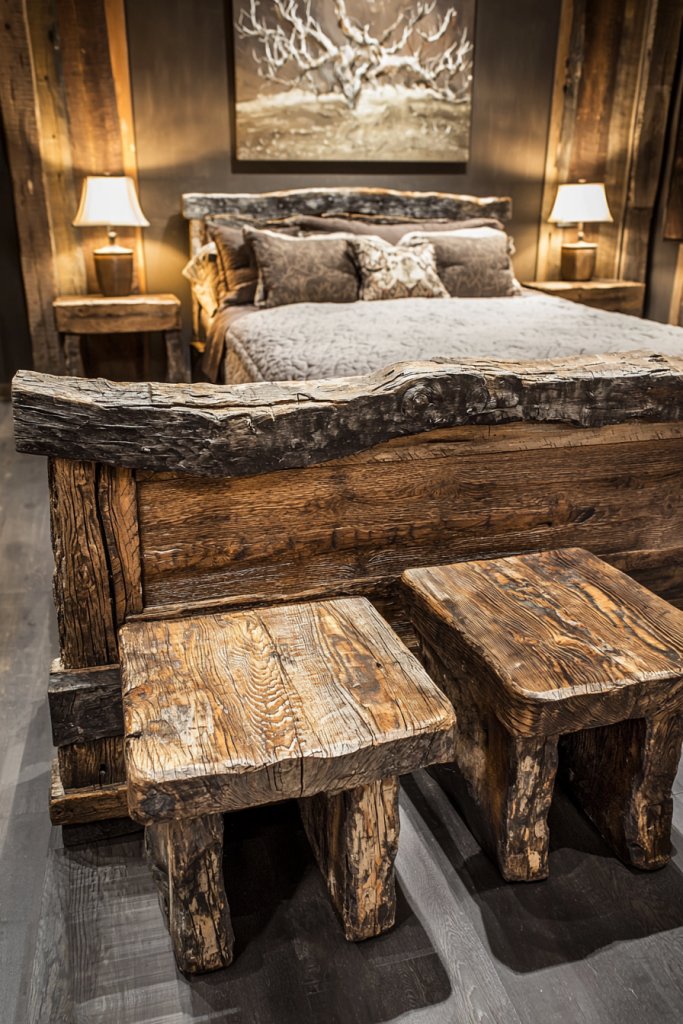
Bringing in weathered wood furniture instantly adds a sense of rustic charm and understated elegance to a Wabi Sabi bedroom, emphasizing natural beauty and imperfection. It’s a subtle way to connect your space to the outdoors and create a calming, grounding environment.
Imagine a low, wide bed frame crafted from reclaimed oak or pine, with visible grain and slight imperfections that tell a story. Surrounding the bed are side tables or dressers with rough-hewn surfaces, showcasing natural knots and uneven textures.
These pieces often feature muted, earthy tones—like soft browns, greys, and whites—that blend seamlessly into the overall neutral palette. The weathered finish not only adds visual interest but also invites tactile exploration, making the space feel warm and inviting.
The scent of aged wood and the tactile richness of the surfaces deepen the sensory experience, enhancing the restful atmosphere. To recreate this look, start by sourcing reclaimed or unfinished wooden furniture from thrift stores, antique markets, or online artisans.
For a DIY touch, lightly sand new wooden pieces and apply a clear, matte sealant to achieve a weathered appearance. Keep the design simple: opt for a low-profile bed frame or side tables with organic shapes and rough textures.
Pair these with soft, neutral-colored linens and minimal accessories to let the natural wood be the focal point. The key is to celebrate imperfection, making the furniture feel both intentional and effortlessly beautiful.
2. Use Neutral Color Palettes with Soft, Earthy Tones
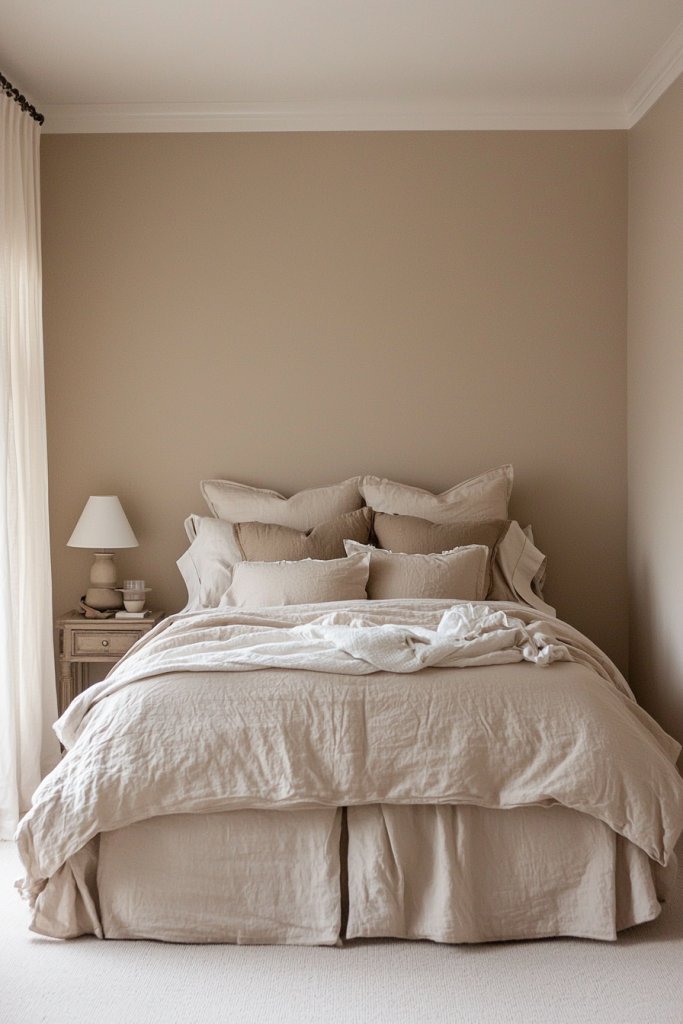
A neutral color palette rooted in soft, earthy tones is essential for creating the serene, harmonious atmosphere characteristic of Wabi Sabi bedrooms. These gentle hues evoke a sense of calm and simplicity, allowing the natural textures and imperfections to stand out.
Visualize a space painted in muted shades like warm beige, stone grey, creamy white, or gentle taupe. These colors serve as a soothing backdrop for textured linens, handcrafted ceramics, and organic materials.
The overall look is understated yet rich in subtle variations—think of a linen duvet cover in a soft oatmeal hue paired with a plush throw in warm sand or clay tones. The palette’s understated nature enhances the tactile experience, encouraging relaxation and mindfulness.
As natural light filters through unadorned linen curtains, the room feels bright and airy, yet grounded in quiet simplicity. To implement this, choose wall colors in matte or eggshell finishes in neutral shades.
Use bedding and textiles in a harmonious mix of soft, earthy tones, avoiding bright or overly saturated colors. Incorporate natural materials like linen, cotton, or wool for a layered, textured look that complements the color scheme.
Accessories should be minimal—perhaps a single ceramic vase or a woven basket—allowing the subtle tones to create a cohesive, peaceful environment. This approach makes your bedroom feel like a retreat—calm, balanced, and effortlessly elegant.
3. Opt for Minimalist Bedding with Textured Linens
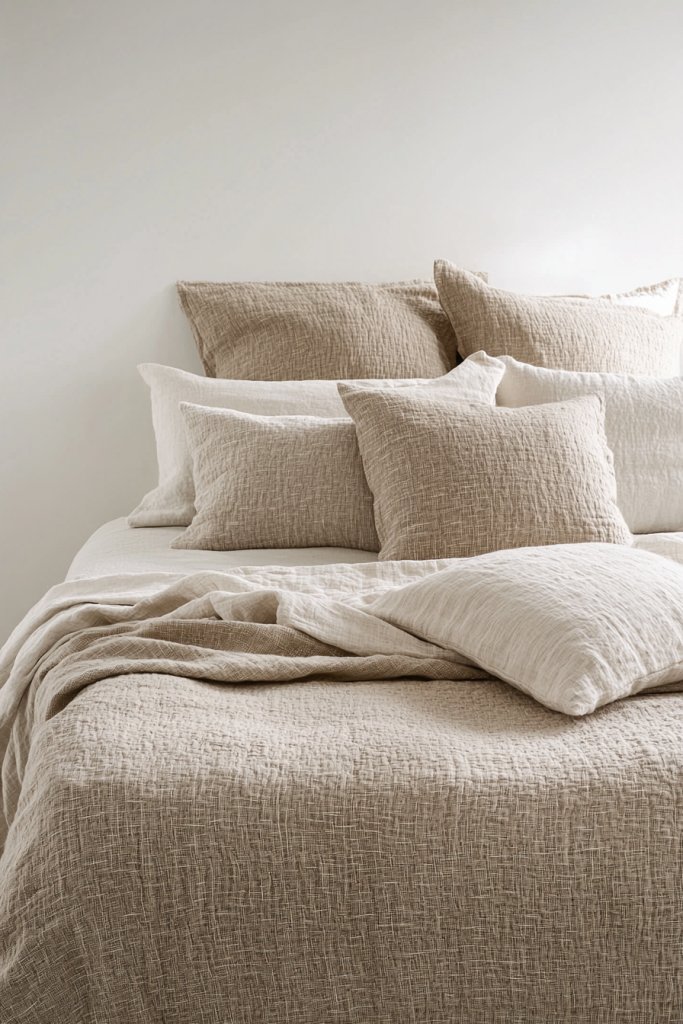
In a Wabi Sabi bedroom, bedding plays a crucial role in cultivating a sense of calm and authenticity through simplicity and texture. Minimalist bedding with textured linens invites touch and visual interest without overwhelming the space.
Picture a crisp, white linen duvet cover paired with a soft, chunky-knit throw in a muted tone—perhaps a dusty grey or warm beige. The linens are intentionally simple, free of elaborate patterns or bright colors, but rich in tactile quality.
Think of natural fibers like linen, cotton, or hemp that develop a beautiful, relaxed crumple over time, adding character and charm. Layering different textures—smooth sheets, a slightly rougher blanket, and a cozy throw—creates depth and invites tactile engagement.
The overall look is effortlessly imperfect, with gentle folds and subtle variations that celebrate natural beauty. The sensory experience is soothing: the coolness of linen, the softness of wool, and the earthy scent of natural fibers.
To achieve this, select high-quality, breathable linens in neutral shades. Opt for simple, well-made pieces that can be easily washed and layered for comfort.
Keep accessories minimal—maybe a single textured pillow or a woven coverlet—to maintain the uncluttered aesthetic. Embrace the natural wrinkles and irregularities, allowing the linens to age gracefully and develop more character over time. This approach fosters a tranquil, inviting atmosphere perfect for restful nights and relaxed mornings.
4. Add Irregularly Shaped Ceramics as Decorative Accents
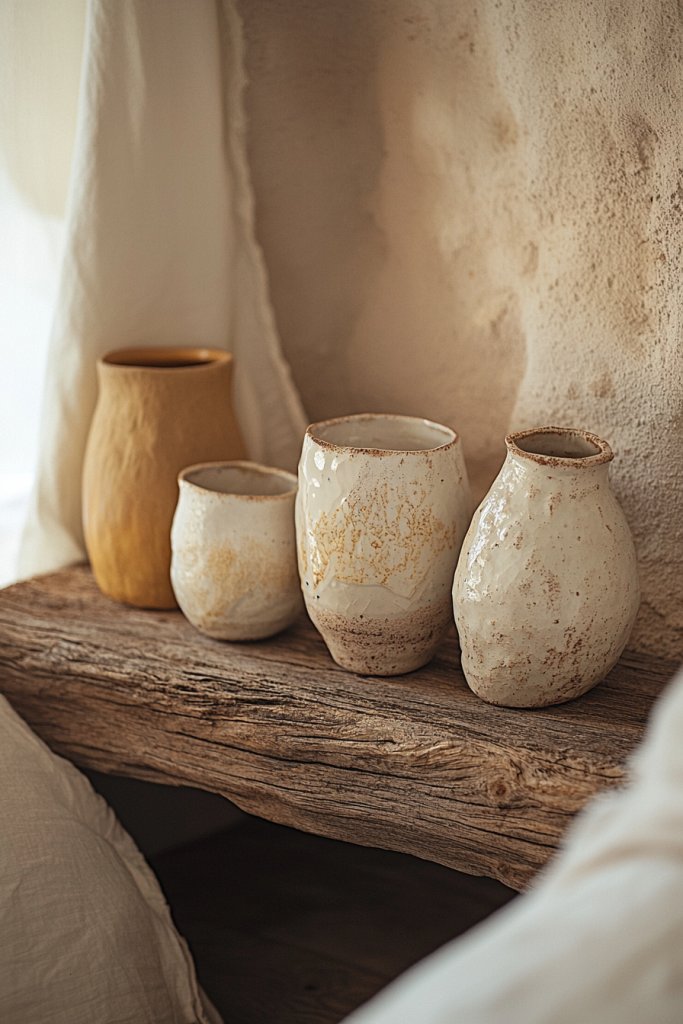
Incorporating irregularly shaped ceramics into a Wabi Sabi bedroom introduces a touch of handcrafted artistry and imperfect beauty that embodies the philosophy of embracing flaws. These unique pieces serve as subtle yet captivating decorative accents that add depth and personality.
Imagine an asymmetric, matte-finished ceramic vase or bowl in earthy tones like terracotta, muted green, or stone grey. These pieces often feature organic, asymmetrical forms—perhaps a slightly lopsided vessel or a handcrafted cup with uneven rims—that highlight their artisanal origin.
Placed on bedside tables, shelves, or window sills, they become focal points that draw the eye with their natural imperfections. The tactile surface and irregular shapes evoke a sense of authenticity and calm, inviting gentle appreciation.
Their subtle presence complements the neutral palette and textured linens, creating a balanced, harmonious visual experience. To incorporate these accents, visit artisan ceramic shops, craft markets, or online stores specializing in handmade pottery.
Choose pieces with earthy glazes and irregular shapes that feel organic and imperfect. Display a few selected items thoughtfully—perhaps a small bowl for jewelry or a vase for dried flowers—ensuring they don’t clutter the space.
Keep the color scheme in line with the room’s overall palette, and pair with simple linens and natural wood elements to reinforce the Wabi Sabi aesthetic. These ceramics add quiet elegance and a sense of mindful imperfection to your bedroom sanctuary.
5. Incorporate Handmade, Wabi Sabi-Inspired Textiles and Throws
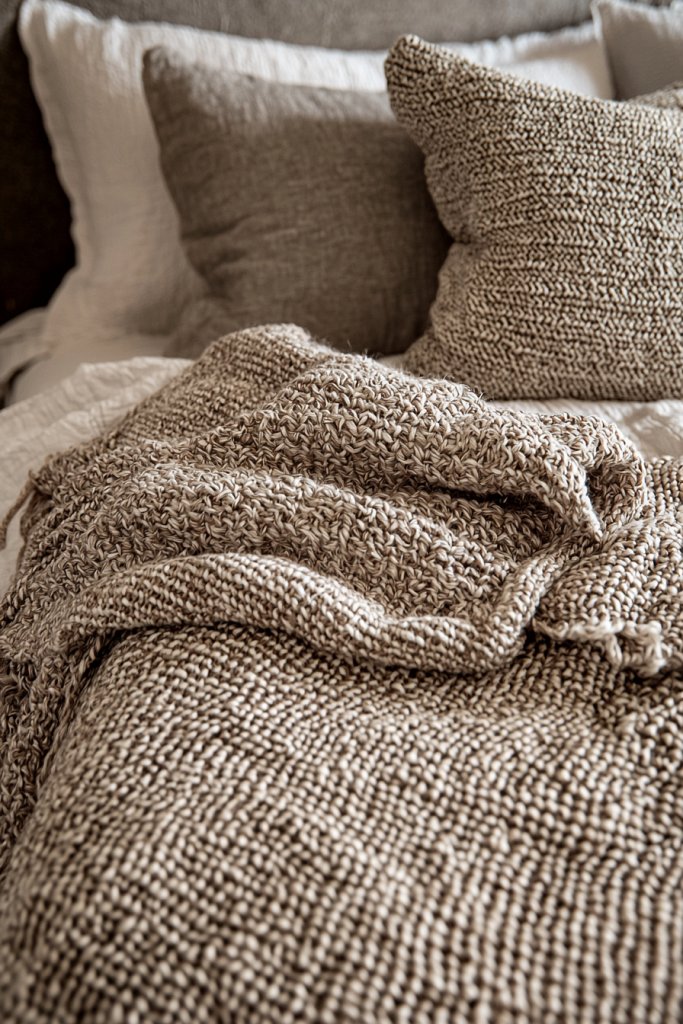
Adding handmade, Wabi Sabi-inspired textiles and throws infuses your bedroom with warmth, tactility, and a sense of personal connection to craftsmanship. These textiles embody the philosophy of beauty in imperfection, making the space feel cozy and authentic.
Imagine a chunky knit throw in a muted, earthy hue like clay or charcoal draped casually over the end of your bed. Complement it with handwoven cushions in natural fibers—perhaps a linen pillow with visible stitching or a burlap cover with frayed edges.
These textiles often feature irregularities such as uneven weaves, slight color variations, or imperfect seams, which celebrate their handmade nature. They invite tactile exploration and add visual richness through subtle textures and muted tones, fostering a calm, lived-in feel.
The combination of soft, textured fabrics with the room’s neutral palette enhances the overall serenity and authenticity. To incorporate these elements, seek out artisanal or small-batch textiles—either handmade or crafted by local artisans.
Look for items with natural, undyed fibers, visible stitches, or intentionally imperfect finishes. Layer a couple of throws or cushions on your bed or armchair, avoiding symmetry for a more relaxed, organic look.
Regularly wash and care for these textiles to deepen their character and softness over time. By choosing handmade and imperfect textiles, you create a warm, inviting bedroom that celebrates the beauty of authentic craftsmanship and natural imperfection.
6. Choose Low-Profile, Organic-Shaped Bed Frames
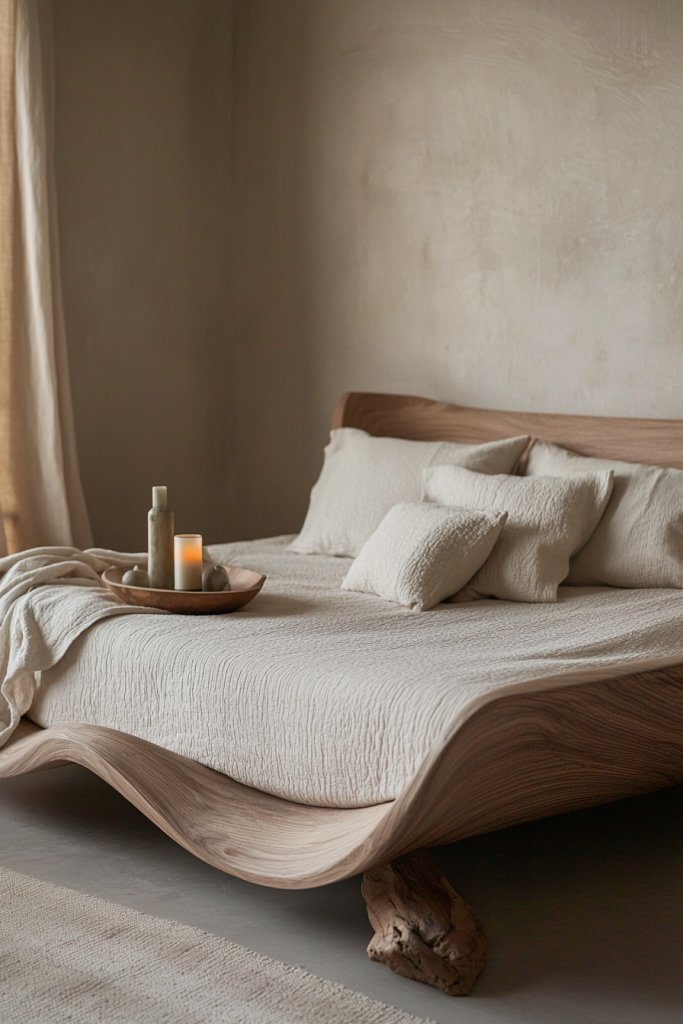
Creating a Wabi Sabi bedroom often starts with selecting a bed frame that embodies simplicity and natural forms. A low-profile, organic-shaped bed frame feels grounded and unobtrusive, emphasizing the beauty of imperfection and craftsmanship.
Think of a frame made from raw, unfinished wood with gentle curves that mimic the natural contours of the landscape, avoiding sharp edges or overly symmetrical lines. The color palette remains muted, with tones like soft beige, weathered gray, or warm taupe, allowing the natural wood grain and textures to become focal points.
The overall look is calming and effortless, inviting a sense of tranquility and ease into the space. Visually, this bed frame appears as if it’s been shaped by nature itself — a piece that’s both functional and sculptural.
Its low height creates a sense of intimacy and closeness to the ground, while the organic curves and irregularities in the wood add character and uniqueness. The bedding complements this aesthetic, featuring textured linens in neutral shades—perhaps a linen duvet with a slightly wrinkled finish and a chunky wool throw at the foot of the bed.
The space feels cozy yet open, with a tactile quality that invites touch and mindfulness. The subtle imperfections of the frame evoke a sense of authenticity, making the room feel lived-in and serene.
To implement this look, start by sourcing a low-profile wooden bed frame—either handcrafted or from brands specializing in natural designs. Opt for unfinished or lightly stained wood, or even consider repurposing reclaimed timber for a more eco-conscious choice.
If building DIY, simple woodworking tools and a bit of patience are all you need; otherwise, look for organic-shaped frames with minimal hardware. Pair it with soft, textured bedding in calming earth tones, and keep the surrounding space uncluttered to emphasize the simplicity and natural beauty of the piece. This approach makes creating a Wabi Sabi sanctuary approachable and rewarding.
7. Integrate Subtle, Asymmetrical Lighting with Warm Glow
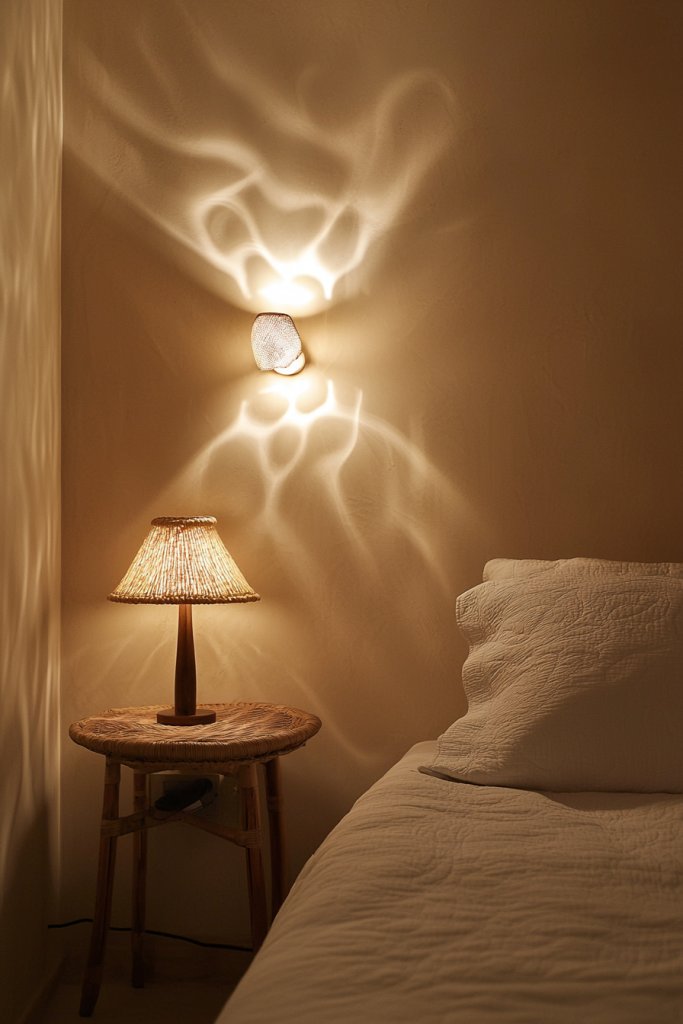
Lighting in a Wabi Sabi bedroom should evoke warmth, softness, and a sense of gentle imperfection. Instead of harsh, symmetrical fixtures, opt for subtle, asymmetrical lighting sources that cast inviting, diffuse glows across the space.
Think of a vintage-style table lamp with a slightly uneven shade, a wall-mounted sconce with an irregular metal finish, or a handcrafted paper lantern with a delicate, imperfect shape. The warm, amber-toned light creates a cozy atmosphere, emphasizing the room’s natural textures and calming palette.
Visually, this lighting setup draws the eye gently around the room, highlighting the textured textiles, weathered woods, and handmade ceramics. The uneven light distribution adds depth and intrigue, mimicking the imperfect beauty found in nature.
Shadows dance softly on the walls, creating a layered, tranquil environment perfect for winding down. The glow should feel inviting and intimate, encouraging relaxation and mindfulness.
This subtle asymmetry and warm illumination reinforce the Wabi Sabi principle of finding beauty in the imperfect and transient. To achieve this, select lighting fixtures with organic shapes and warm-toned bulbs—think Edison filament bulbs or dimmable LEDs with a warm color temperature (around 2200K).
Incorporate wall sconces at different heights or place a table lamp on a side table with a handcrafted or vintage shade. Use dimmer switches to control brightness and create a customizable atmosphere.
Keep the wiring discreet, and focus on the quality and warmth of the light rather than elaborate fixtures. With a few thoughtfully chosen lighting pieces, your bedroom will glow with a subtle, imperfect charm that feels both intentional and serene.
8. Display Simple, Imperfect Pottery or Vessels as Decor
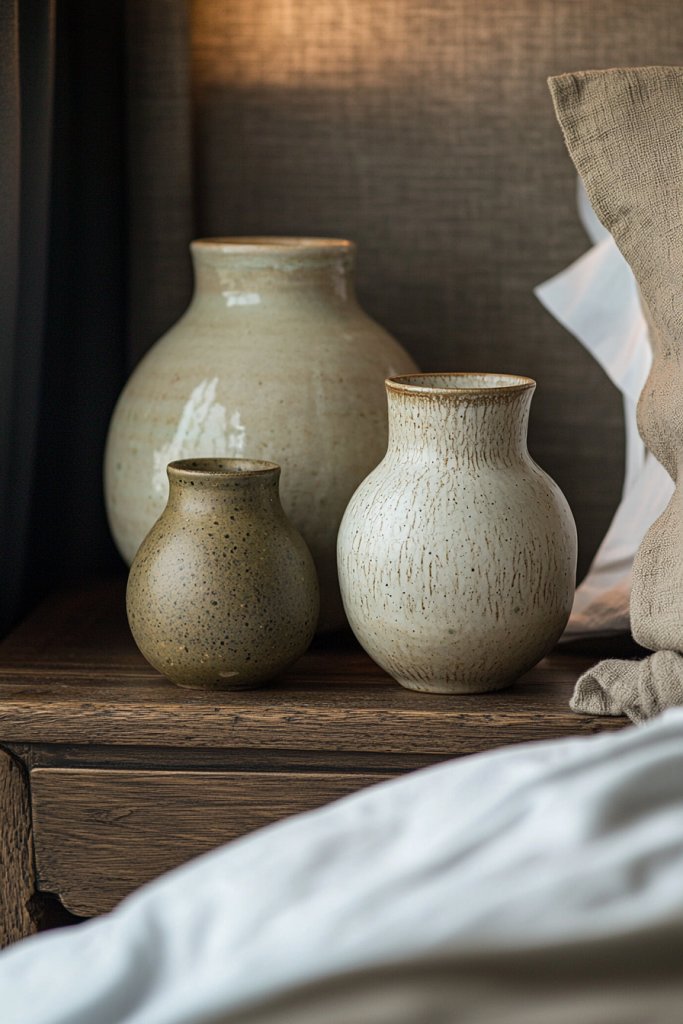
In a Wabi Sabi bedroom, carefully curated pottery or vessels serve as understated decorative accents that highlight imperfection and craftsmanship. These objects often feature irregular shapes, uneven glazes, or subtle cracks, emphasizing their handmade quality and natural beauty.
They can be used as vases, candle holders, or purely as sculptural decor. Neutral colors like matte white, earthy terracotta, or muted gray enhance their organic appeal, creating a harmonious and calming visual flow.
Visually, these pottery pieces are quietly striking—each one unique, with subtle variations that tell a story of their creation. For example, a small, asymmetrical bowl with a crackled glaze or a lopsided vase with a textured surface adds depth and character to the space.
Arranged in small clusters or individually on shelves, these vessels provide an element of tactile interest and visual balance. Their simplicity invites a moment of pause, encouraging appreciation for the imperfect beauty inherent in natural materials.
The overall effect is a serene, curated collection that elevates the room’s understated elegance. To incorporate these decor objects, seek out handmade pottery from artisans or craft markets, or explore local ceramic studios.
Look for pieces that show visible signs of the handmade process—such as uneven rims, glaze drips, or organic shapes. Display them on open wooden shelves, on bedside tables, or atop a simple dresser, pairing them with dried flowers or small stones for added texture.
If you enjoy DIY, try creating your own pottery with beginner-friendly clay kits. The key is to select objects that feel authentic, imperfect, and deeply connected to the Wabi Sabi aesthetic, fostering a space of quiet beauty and reflection.
9. Embrace Negative Space with Clutter-Free Surfaces
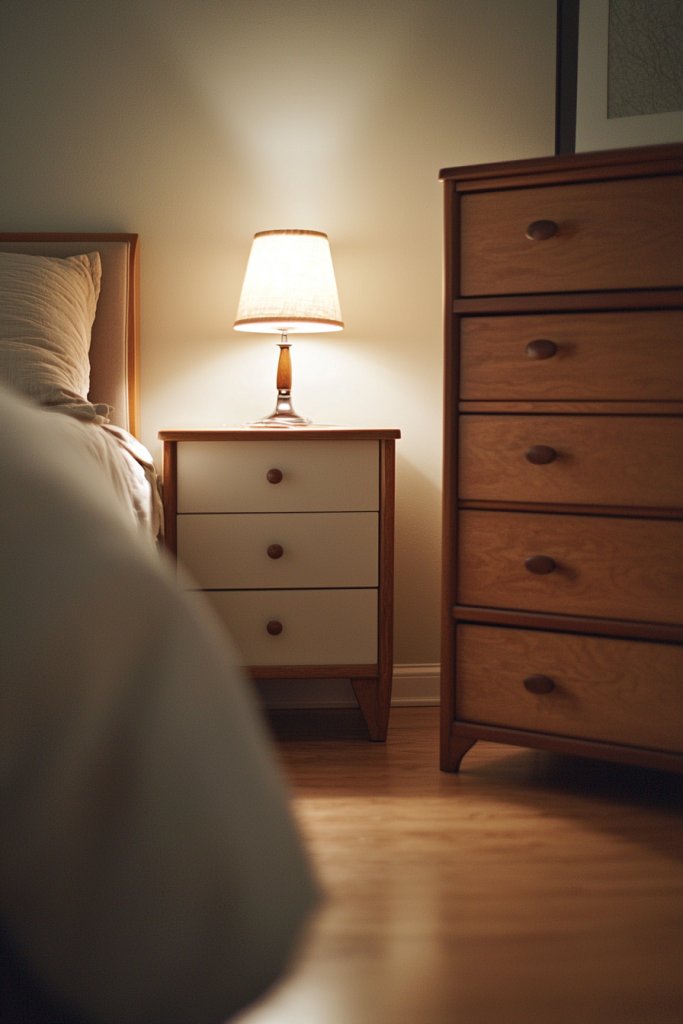
A hallmark of Wabi Sabi design is the intentional use of negative space to cultivate calm and focus. In a bedroom, clutter-free surfaces—be they nightstands, dressers, or shelves—allow the eye to rest and highlight the few carefully selected objects that truly matter.
This minimalist approach emphasizes quality over quantity, with each item purposefully placed and meaningful. The result is a space that feels open, peaceful, and free of distraction, inviting mindfulness and relaxation.
Visually, the room appears airy and uncluttered, with surfaces kept intentionally bare or sparsely decorated. For instance, a single textured ceramic vessel or a small, handcrafted sculpture might sit atop a nightstand, with plenty of space around it.
The absence of excess items reveals the subtle imperfections and natural materials used throughout the room—weathered wood, linen textiles, and soft lighting—creating a harmonious balance. This deliberate simplicity enhances the serene atmosphere and allows the natural textures and finishes to take center stage.
The overall effect is a tranquil sanctuary that embodies Wabi Sabi’s appreciation for the beauty of emptiness and subtlety. To achieve this, regularly declutter and prioritize only essential or meaningful objects in your bedroom.
Use storage solutions like woven baskets or hidden compartments to keep surfaces tidy. When adding decorative items, choose a few that evoke calm and authenticity—such as a handmade ceramic cup or a simple linen pouch.
Maintain a sense of openness by leaving ample space between items, and avoid over-accessorizing. This mindful curation of negative space fosters a peaceful environment that promotes rest and reflection, making your bedroom a true retreat from the chaos of everyday life.
10. Layer Textures with Wool, Linen, and Burlap for Cozy Depth
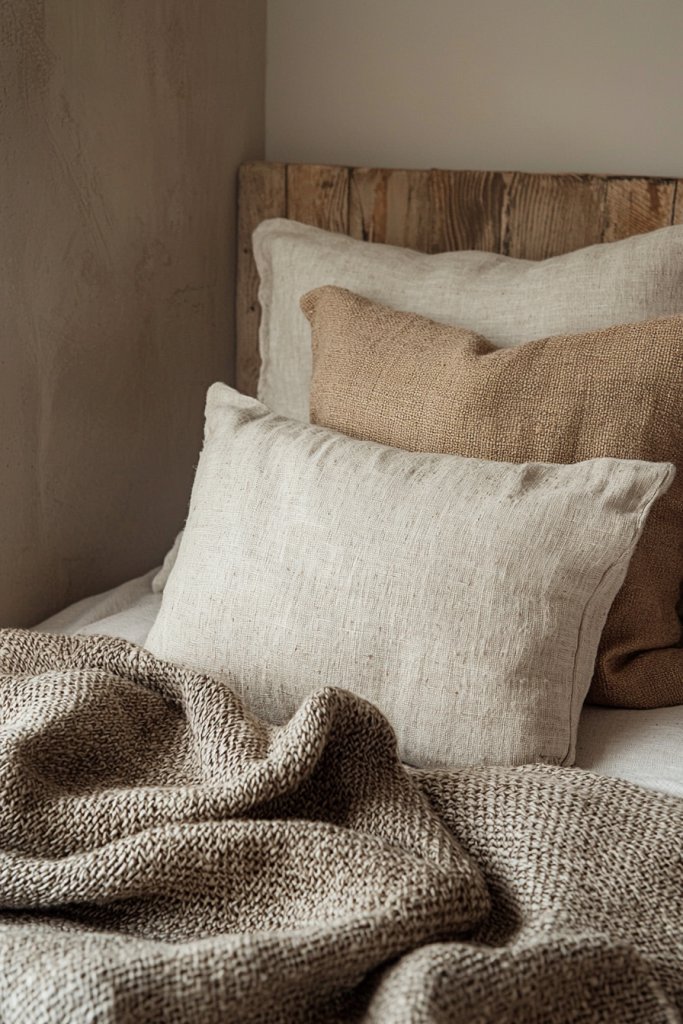
Creating a welcoming, tactile environment in your Wabi Sabi bedroom is all about layering different textures to evoke comfort and understated elegance. Think of pairing a chunky wool throw blanket with a soft, crinkled linen duvet cover, and adding a natural burlap cushion or two on the bed.
These materials, with their varied weaves and finishes, invite touch and add visual interest without overwhelming the simplicity of the space. The cozy depth they create makes the room feel warm and lived-in, yet intentionally imperfect—perfectly aligned with Wabi Sabi principles.
Visually, imagine a bed dressed in a slightly wrinkled linen sheet in muted beige or soft gray, topped with a textured wool blanket in deep charcoal or warm cream. Throw in a burlap cushion or a woven wool pillow for added dimension, their rough textures contrasting beautifully with smoother surfaces.
The combination of these textiles introduces subtle shifts in light and shadow, emphasizing the room’s organic feel. As you move through the space, your senses are subtly engaged—soft fabrics inviting touch, warm hues calming the mind, and imperfect, layered textures reinforcing the serene, cozy atmosphere.
To recreate this look, start with a neutral-colored linen duvet or coverlet, which is widely available and beginner-friendly. Add a chunky wool throw, perhaps in a natural or earthy tone—these are often found at home goods stores or can be DIY’d from old sweaters.
Incorporate burlap accents through cushions or wall hangings, or even a simple burlap runner. Mixing and layering these textures in a balanced, unpretentious way will instantly deepen the room’s tactile richness and create that cozy, imperfect charm essential to Wabi Sabi interiors.
11. Incorporate Natural Fibers in Rugs and Curtains for a Touched-By-Nature Feel
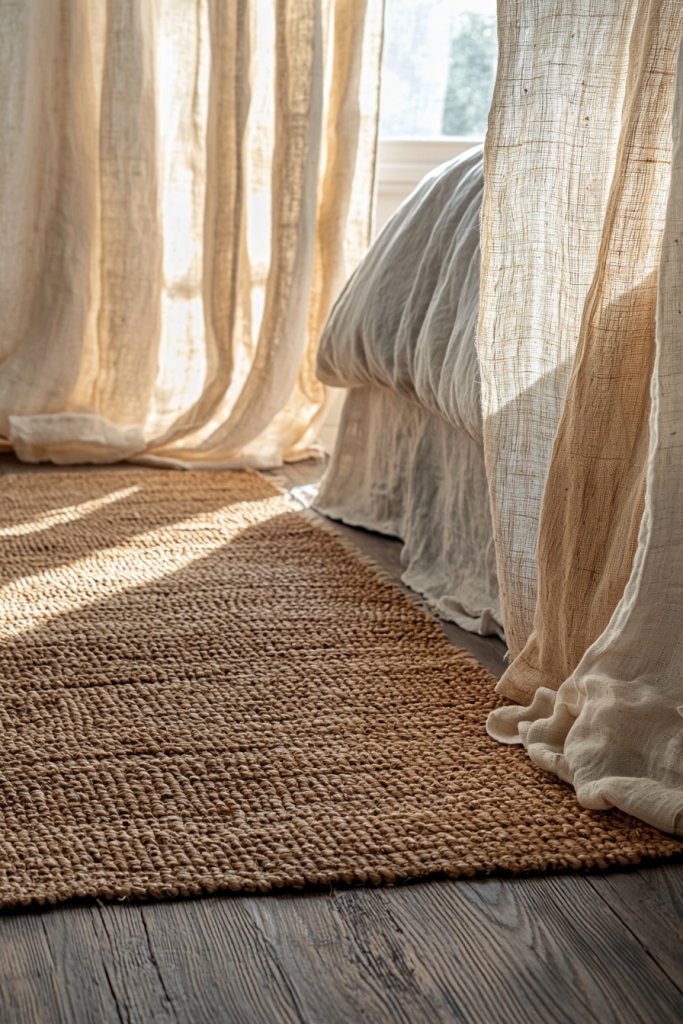
Using natural fibers in your bedroom decor amplifies the authentic, organic essence central to Wabi Sabi. Think of woven jute or sisal rugs underfoot, and lightweight linen or hemp curtains fluttering softly at the windows.
These materials are not only sustainable and durable but also add a raw, tactile dimension that grounds the space in nature. Their subtle imperfections and earthy tones foster a peaceful, grounded atmosphere—perfect for a bedroom that celebrates simplicity and imperfection.
Picture a room with a large, textured jute rug in warm, sandy hues anchoring the space, its coarse fibers adding visual and tactile warmth. Flanking the windows are loosely hung linen curtains in muted tones like taupe or stone, gently diffusing natural light while softly swaying with air movement.
The tactile quality of these materials invites barefoot comfort and creates a sensory connection to the outdoors. Their simple, unpretentious appearance complements other natural elements, reinforcing the Wabi Sabi aesthetic of understated beauty.
To achieve this look, choose a durable, eco-friendly rug made of jute, sisal, or seagrass, which are widely available at home stores or online. For curtains, opt for unbleached linen or hemp in neutral shades—these are easy to hang with simple curtain rods or tension wires for a minimalist look. Combining these natural fibers with minimal accessories allows the textures to speak for themselves, creating a bedroom that feels both touched by nature and perfectly imperfect.
12. Select Wabi Sabi-Inspired Bedside Tables with Raw Finishes
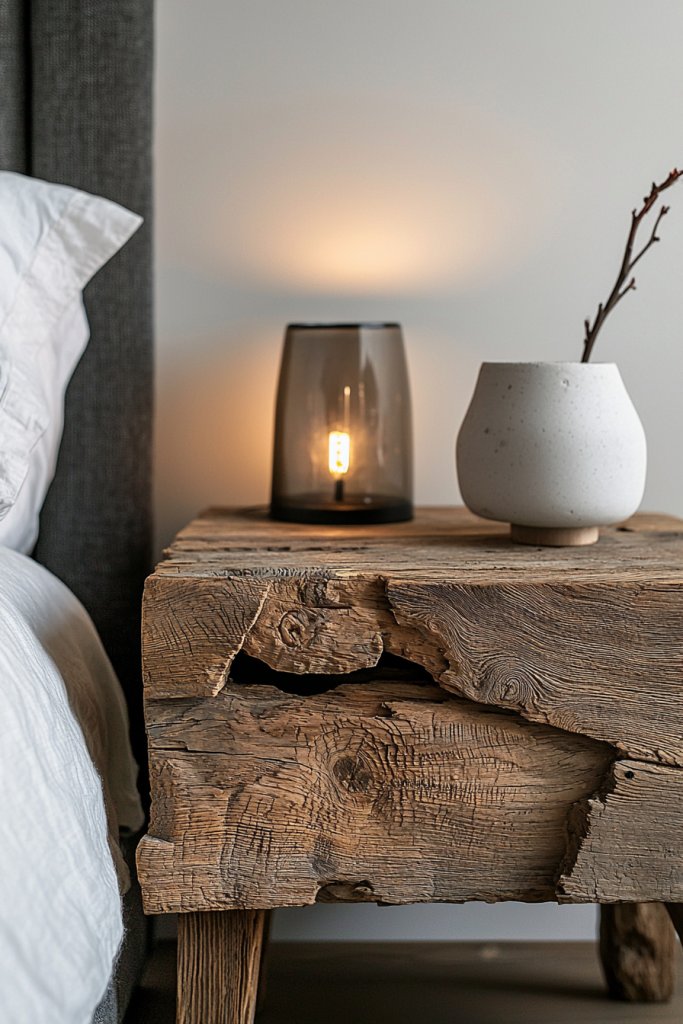
A Wabi Sabi-inspired bedside table is all about embracing raw, organic finishes that highlight the beauty of imperfection. Think of a simple, low-profile wooden table with an unfinished or distressed surface—perhaps with visible knots, grain patterns, or an uneven edge.
Such pieces evoke a sense of history and authenticity, adding character and depth to the bedroom without the need for ornate detailing. They serve as functional yet artful focal points that embody the Wabi Sabi principle of embracing the imperfect.
Visualize a small, handmade wooden table in weathered oak or reclaimed pine, its surface slightly rough and unpolished, with natural imperfections showing through. It might have a simple design, with clean lines but a visibly textured finish that celebrates the material’s natural state.
The table’s organic shape and raw surface contrast gently with softer textiles in the room, creating a harmonious balance between rustic authenticity and understated elegance. The overall effect is calming, grounding, and beautifully imperfect.
To implement this, look for reclaimed wood or handcrafted furniture from local artisans or vintage shops. You can also DIY a simple table by repurposing an old wooden crate or pallet, sanding it minimally to preserve its natural character.
Keep the finish raw or seal it lightly with natural oils, avoiding anything glossy or overly refined. This approach ensures your bedside table becomes a genuine Wabi Sabi statement piece—functional, imperfect, and full of quiet charm.
13. Use Woven Baskets and Organic Storage Solutions for Practicality
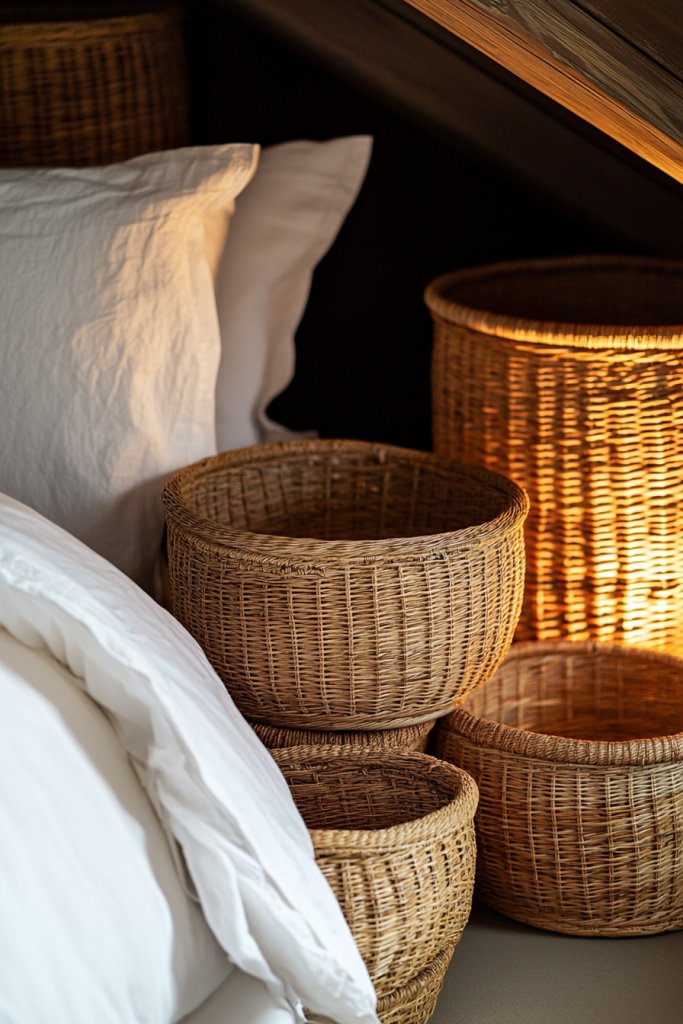
In a Wabi Sabi bedroom, storage is both functional and a part of the decor’s natural aesthetic. Woven baskets, made from rattan, seagrass, or willow, are ideal for keeping clutter out of sight while adding texture and warmth to the space.
Their organic shapes and imperfect weaving patterns reflect the Wabi Sabi celebration of natural materials and craftsmanship, creating a sense of harmony and simplicity. Imagine placing a large, hand-woven basket at the foot of the bed for storing extra blankets or clothing.
Its irregular weave and earthy tones—like warm beige or muted brown—blend seamlessly with the room’s neutral palette. Smaller baskets on shelves or beside the bed can hold essentials like books, jewelry, or loose items, maintaining a clutter-free environment that feels calm and welcoming.
These baskets add visual interest through their tactile quality, enhancing the room’s understated beauty. To incorporate woven baskets, purchase or craft options from local artisans or eco-friendly brands.
Select pieces in natural fibers with simple shapes—round, oval, or rectangular—that suit your space’s proportions. For a DIY option, you could repurpose old rattan or wicker to create your own baskets with minimal tools. Their organic, imperfect appearance complements the Wabi Sabi ethos, making organization both practical and aesthetically aligned with the overall design.
14. Add Handmade, Wabi Sabi-Inspired Decorative Objects (e.g., Driftwood, Stones)
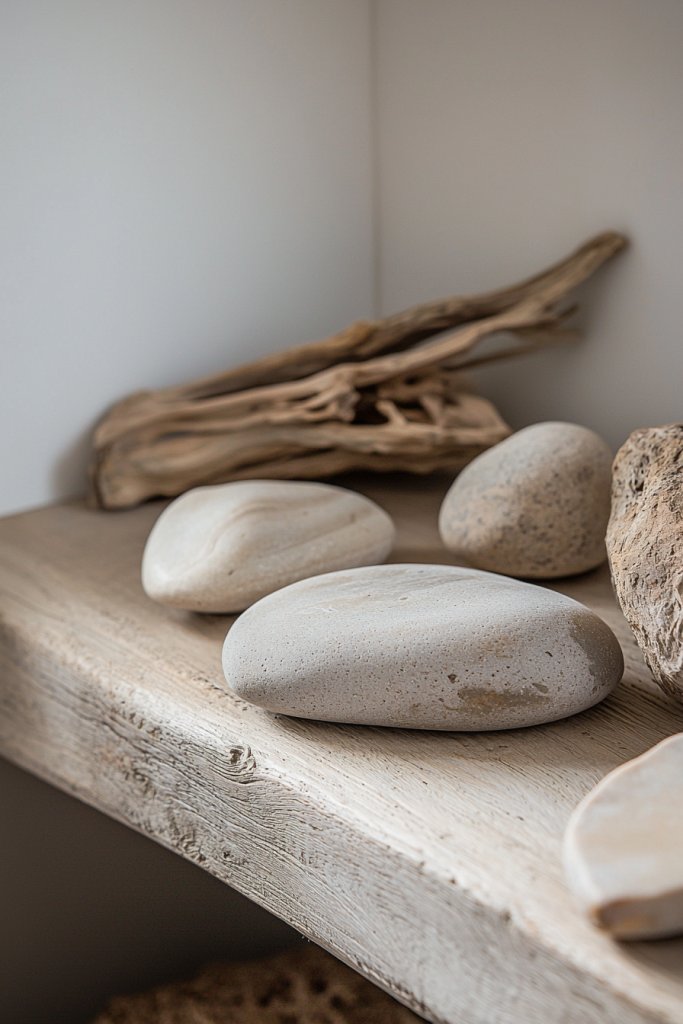
Decorating with handmade, natural objects like driftwood, stones, or bowls crafted from imperfect ceramics embodies the Wabi Sabi appreciation for rustic beauty and imperfection. These elements bring a sense of calm, grounding the bedroom in natural textures and forms that feel authentic and unpretentious.
Their irregular shapes and subtle imperfections evoke a sense of history and quiet resilience, elevating the space’s serenity. Visualize a bedside table or shelf displaying a collection of weathered driftwood pieces with uneven edges, or a bowl filled with smooth, naturally shaped stones in muted tones of gray, beige, or slate.
These objects have tactile appeal and irregular forms that invite quiet contemplation. Arranged thoughtfully, they serve as focal points that highlight nature’s imperfect artistry, contributing to an environment that is both peaceful and subtly intriguing.
To incorporate these objects, visit beaches, riverbanks, or craft markets to find authentic driftwood and stones. Alternatively, source handmade ceramics from local artisans or online craft communities—look for pieces with visible hand-thrown marks or irregular glazes.
Place them intentionally on shelves, bedside tables, or mantels, balancing their organic irregularities with the calm simplicity of your room’s overall design. These natural touches deepen the Wabi Sabi aesthetic and foster a tranquil, unpretentious vibe.
15. Keep Windows Unadorned or with Simple, Linen Curtains to Maximize Natural Light
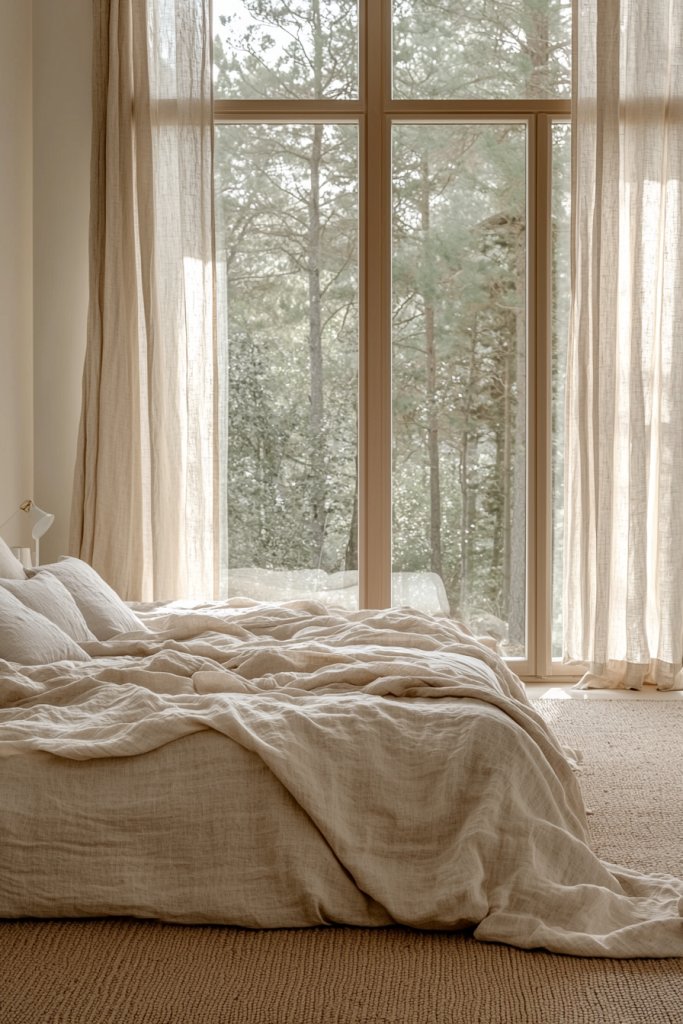
Natural light is a cornerstone of Wabi Sabi interiors, creating an airy, calming atmosphere that emphasizes simplicity and authenticity. Keeping windows unadorned or minimally dressed allows sunlight to flood the space, highlighting textures and raw materials while fostering a sense of openness and tranquility.
This approach also prevents visual clutter, making the room feel more expansive and serene. Imagine wide, unobstructed windows revealing views of the sky or natural landscape, softened by sheer, linen curtains in muted, earthy tones like warm beige or stone gray.
The fabric’s natural fibers add subtle texture, gently diffusing sunlight and casting soft shadows across textured walls and wooden surfaces. The overall effect is a space that feels connected to the outdoors, with gentle light that shifts throughout the day, creating a peaceful ambiance that invites you to breathe deeply and relax.
To recreate this look, start by removing heavy or ornate window treatments. For a minimal, Wabi Sabi aesthetic, choose simple linen curtains or sheer fabrics in neutral shades.
Hang them loosely on plain rods, allowing the fabric to drape naturally without tight pleats or embellishments. If privacy isn’t a concern, leave the windows bare. For a cozy touch, you can add lightweight, raw-finished bamboo blinds that can be rolled up or down as needed, maintaining the room’s understated elegance and maximizing natural light.
16. Incorporate Imperfect, Reclaimed Materials for a Sense of History
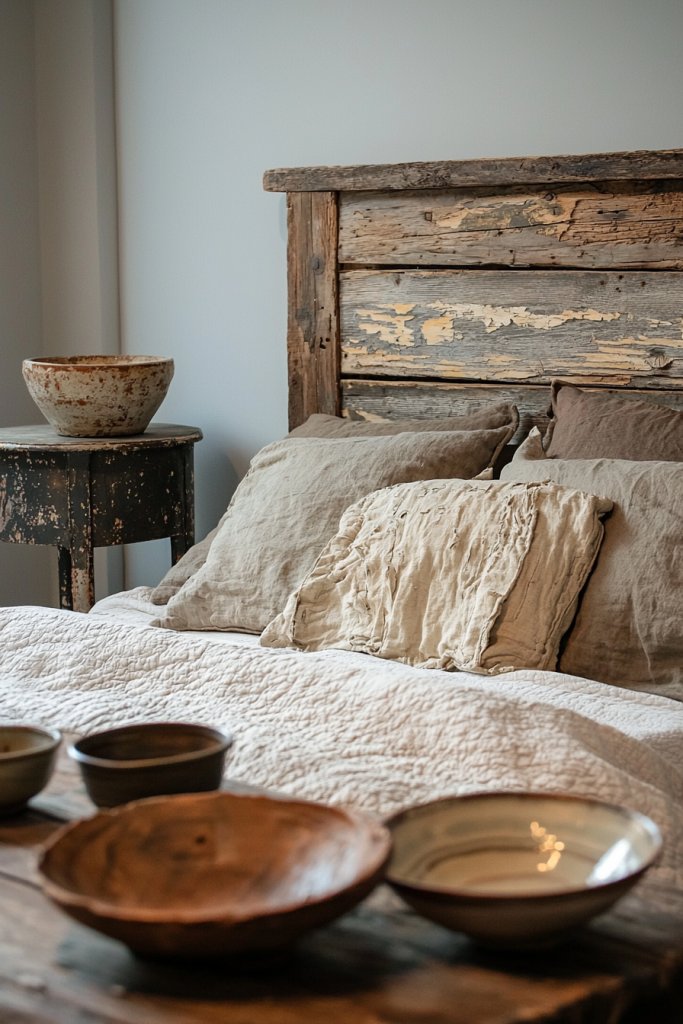
Using reclaimed and imperfect materials infuses a Wabi Sabi bedroom with a sense of history and authenticity. These elements celebrate the beauty of age, wear, and imperfection, creating a space that feels deeply rooted and uniquely personal.
Reclaimed wood, distressed finishes, and weathered surfaces evoke stories and character, enriching the room’s serene, rustic charm. Picture a bed frame made from salvaged barn wood, its surface marked with knots, cracks, and uneven grains that tell a story of its journey.
Pair this with shelves or nightstands crafted from reclaimed pallets or vintage crates, their rough textures and faded paint adding visual interest. These pieces, combined with soft, natural textiles and minimal decor, foster a cozy yet slightly imperfect aesthetic that encourages mindfulness and appreciation for transience.
To implement this idea, look for local salvage yards, antique stores, or online marketplaces specializing in reclaimed materials. For example, sourcing a reclaimed wooden headboard or vintage wooden side table can instantly add character.
If you’re handy, consider repurposing old wood by sanding or sealing it lightly to preserve the weathered look, avoiding overly polished finishes. Pair these with simple linen bedding and organic textiles to balance the rugged textures with softness, creating a harmonious, lived-in sanctuary.
17. Use Soft, Muted Lighting to Create a Calm, Serene Atmosphere
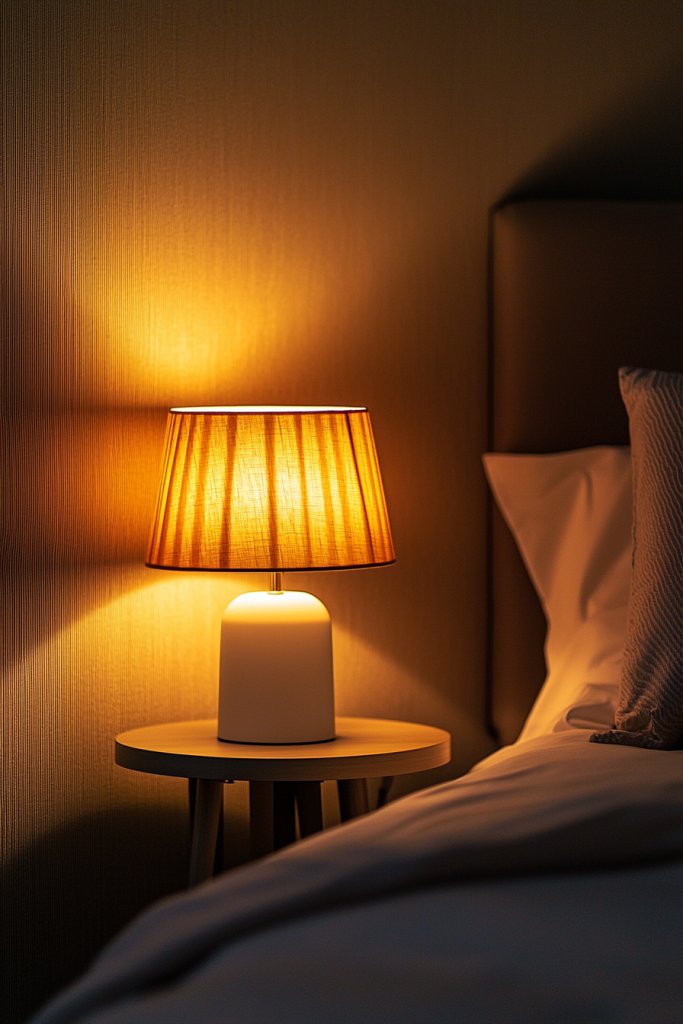
Lighting plays a pivotal role in establishing the tranquil, contemplative mood essential to Wabi Sabi bedrooms. Opting for soft, muted lighting helps to gently diffuse brightness, eliminating harsh shadows and creating a warm, inviting glow that encourages relaxation and introspection.
The goal is to craft an environment that feels peaceful and undisturbed, perfect for unwinding. Visualize a bedside lamp with a textured, ceramic base in earthy tones—perhaps a matte taupe or soft clay—paired with a linen shade that filters warm light.
Alternatively, string lights with dimmable settings softly illuminate the space, adding a touch of gentle ambiance. The overall lighting should be subtle, avoiding glaring bulbs or overly bright fixtures, and instead emphasizing a layered approach that combines ambient, task, and accent lighting for a cohesive, calming effect.
For easy implementation, choose warm LED bulbs (around 2700K) that mimic incandescent tones, and install dimmer switches to control brightness. Incorporate table lamps with natural fiber or ceramic bases and simple, neutral shades.
To enhance the serene atmosphere, position lights near textured walls or decorative ceramics to cast delicate shadows, enriching the space’s tactile qualities. Keep the lighting minimal but thoughtfully layered to maintain that subtle, peaceful glow essential for a Wabi Sabi bedroom.
18. Incorporate Subtle, Asymmetrical Arrangement of Decor for Visual Interest
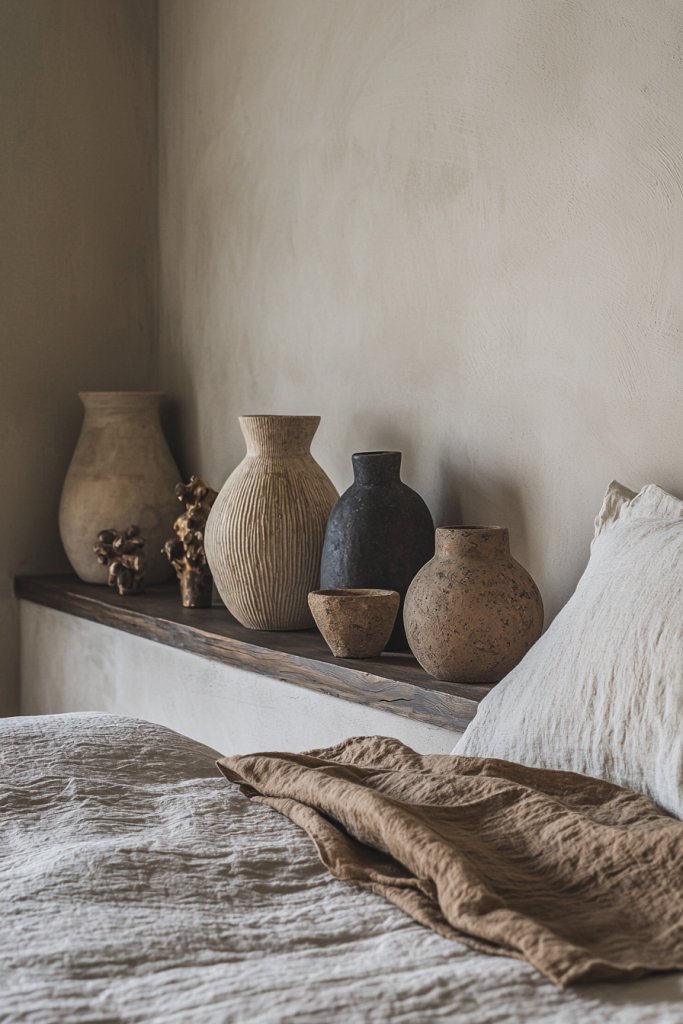
In Wabi Sabi design, asymmetry is a key principle that introduces visual interest without clutter or perfection. Arranging decor in a subtle, unbalanced way creates a dynamic yet harmonious space that feels natural and effortless.
This approach encourages the eye to explore the room, highlighting the beauty of imperfection and organic balance. Envision a collection of simple ceramics or textured vessels displayed unevenly on a shelf or bedside table—some slightly higher or lower than others, with varying shapes and sizes.
Or imagine a carefully curated grouping of organic objects like driftwood, stones, or woven baskets arranged off-center, deliberately avoiding symmetry. This asymmetrical style invites a sense of flow and spontaneity, making the space feel more alive and authentic.
To achieve this, start by selecting a few favorite decorative objects—such as handmade ceramics or worn wooden sculptures—and arrange them in a loose, unstructured way. Avoid perfect alignments; instead, trust the natural tendencies of the objects.
Adjust their placement until the arrangement feels balanced but not symmetrical, paying attention to negative space. This subtle imbalance fosters a peaceful, inviting atmosphere that embodies the essence of Wabi Sabi’s appreciation for imperfection and natural harmony.
19. Choose Functional, Unpretentious Furniture with Simple Lines
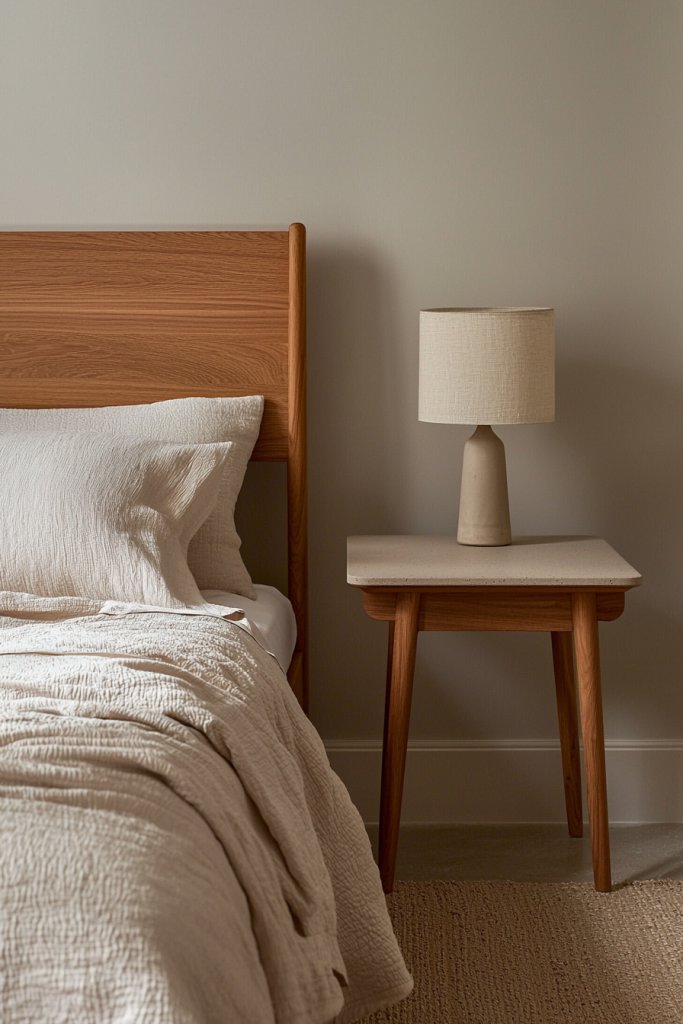
In a Wabi Sabi bedroom, furniture should prioritize function and simplicity over ornate design or excessive decoration. Pieces with clean, straightforward lines and unpretentious forms foster a sense of calm and ease, allowing natural textures and materials to take center stage.
The focus is on creating a space that feels honest, comfortable, and effortlessly beautiful. Imagine a low-profile platform bed made from raw, unfinished wood with minimal detailing, paired with a simple, sturdy bedside table—perhaps a rough-hewn wooden block or a woven wicker basket.
The furniture’s shape is unadorned, emphasizing its natural material and craftsmanship. This approach avoids clutter or overly decorative elements, instead inviting you to appreciate the form and texture of each piece.
To implement, select furniture made from natural, sustainable materials like untreated wood, bamboo, or wicker. Look for pieces with straight, unembellished lines and avoid overly ornate or glossy finishes.
For a budget-friendly option, consider secondhand finds or DIY projects using raw timber. Keep the layout uncluttered, ensuring each piece serves a clear purpose, reinforcing the sense of simplicity and functionality that defines Wabi Sabi design.
20. Maintain a Clutter-Free Space to Enhance the Tranquility and Simplicity
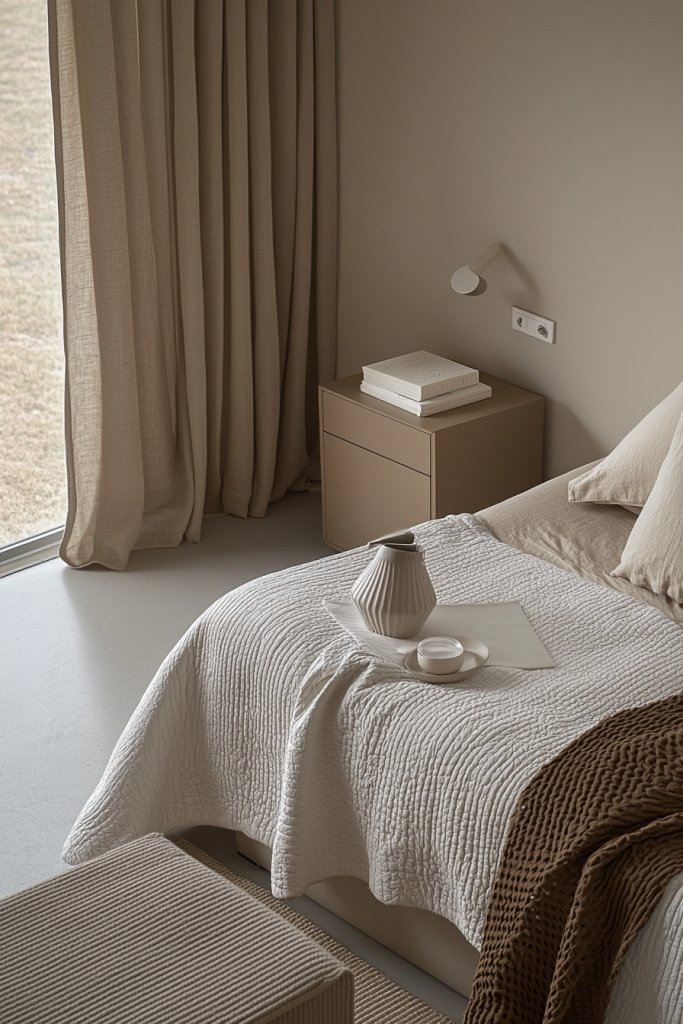
A clutter-free bedroom is the cornerstone of Wabi Sabi’s embrace of serenity and understated beauty, transforming your space into a calming retreat. Removing excess items helps foster a sense of peace, allowing the natural textures and imperfect details to shine through.
Imagine stepping into a bedroom where the surfaces are intentionally kept clear, with only a few meaningful objects subtly displayed—perhaps a single textured ceramic vessel or a worn wooden tray. The room feels open and airy, with soft, neutral tones on the walls and bedding.
The tactile contrast of rough-hewn wood, woven baskets, and linen textiles adds warmth without overwhelming the senses. The overall atmosphere is quiet, with gentle natural light filtering through simple linen curtains, highlighting the beauty of negative space and imperfect forms.
This visual simplicity invites a moment of stillness, making every element feel intentional and tranquil. To create this calm environment, start by decluttering your space, removing unnecessary furniture and items that don’t serve a purpose or add emotional value.
Use storage solutions like woven baskets or vintage boxes to hide away clutter, and keep surfaces like nightstands and dressers minimal—ideally only displaying a few textured ceramics, a candle, or a small handcrafted object. Regularly reassess your space, ensuring everything has a designated place.
Focus on choosing quality, tactile objects that evoke a sense of history or natural beauty, and resist the urge to fill every corner. Achieving a clutter-free bedroom not only enhances aesthetic harmony but also nurtures your mental well-being through simplicity and calm.
Conclusion
Transforming your bedroom into a tranquil Wabi Sabi sanctuary is all about embracing natural materials, imperfect beauty, and thoughtful simplicity. From weathered wood and handmade textiles to asymmetrical decor and clutter-free spaces, these ideas invite you to cultivate a subtle, serene environment that reflects authenticity and calm. Give these concepts a try and create a space that nurtures peace and mindful living—your perfect Wabi Sabi retreat awaits!
Leave a Reply